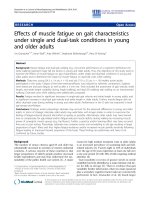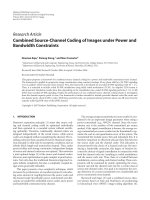Infiltration characteristics of soil under acacia and pine plantation forest in van don district quang ninh province
Bạn đang xem bản rút gọn của tài liệu. Xem và tải ngay bản đầy đủ của tài liệu tại đây (1.66 MB, 60 trang )
ACKNOWLEDGEMENT
This project consumed a huge amount of work and research. Still, implementation
would not have been possible if I did not have a support of many individuals and
organizations. Therefore, I would like to extend my sincere gratitude to all of them.
First of all, I am thankful to Assoc. Prof. Bui Xuan Dung for his valuable and
constructive suggestions, patient guidance, enthusiastic encouragement and useful critiques
during the planning and development of this research work. His willingness to give his time
so generously has been very much appreciated.
I am also grateful to the laboratory of Vietnam National University of Forestry for
provision of technical support in the implementation.
I would like to express my sincere thanks towards my friends who devoted their time
and knowledge in the implementation of this project.
Nevertheless, I express my gratitude toward my family for their kind co-operation and
encouragement which help me in completion of this research.
i
TABLE OF CONTENTS
ACKNOWLEDGEMENT ......................................................................................................... i
TABLE OF CONTENTS ........................................................................................................... ii
LIST OF TABLES .................................................................................................................... iv
LIST OF FIGURES .................................................................................................................... v
ABSTRACT ............................................................................................................................ viii
I. INTRODUCTION................................................................................................................... 1
II. GOALS AND OBJECTIVES ................................................................................................ 4
2.1. Goals .................................................................................................................................... 4
2.2. Objectives ............................................................................................................................ 4
III. STUDY SITE AND METHOD: .......................................................................................... 5
3.1. Study site: ............................................................................................................................ 5
3.1.1. Location: ........................................................................................................................... 5
3.1.2. Characteristics of tree species........................................................................................... 6
3.2. Method:................................................................................................................................ 9
3.2.1. Field experiment for infiltration measurement ................................................................. 9
3.2.2. Determining influencing factors ..................................................................................... 14
3.2.3. Data analysis by using software ..................................................................................... 17
IV. RESULTS AND DISCUSSION: ....................................................................................... 18
4.1. Temporal infiltration characteristics of Pine and Acacia plantation forest: ...................... 18
4.1.1. Temporal infiltration characteristics under Acacia plantation forest ............................. 18
4.1.2. Temporal infiltration characteristics under Pine plantation forest: ................................ 22
4.1.3. Total water infiltrated in 1 hour:..................................................................................... 26
4.2. Spatial infiltration characteristics of Pine and Acacia plantation forest:........................... 28
4.2.1. The first layer: ................................................................................................................ 28
ii
4.2.2. The second layer: ............................................................................................................ 29
4.2.3. The third layer: ............................................................................................................... 30
4.2.4. The fourth layer: ............................................................................................................. 31
4.2.5. Spatial infiltration of three plots: .................................................................................... 32
4.3. The factors impact on infiltration characteristics. ............................................................. 35
4.3.1. Characteristics of factors in two types of forest ............................................................. 35
4.3.2. Effect of factors on infiltration: ...................................................................................... 39
4.4. Recommending some solutions to protect soil and better management the forest. ........... 42
V. CONCLUSION, LIMITATIONS AND RECOMMENDATIONS .................................... 46
5.1. Conclusion: ........................................................................................................................ 46
5.2. Limitations ......................................................................................................................... 47
5.3. Recommendation: .............................................................................................................. 47
REFERENCES
APPENDIX
iii
LIST OF TABLES
Table 3.1. Data of infiltration evaluated. .................................................................................. 10
Table 3.2. Information of survey plots ..................................................................................... 12
iv
LIST OF FIGURES
Figure 3.1. a) Location of study site, b)Contour map of study site ............................................ 5
Figure 3.2. Morphology of Acacia mangium ............................................................................. 6
Figure 3.3. Morphology of Pinus Merkusii ................................................................................ 8
Figure 3.4. Tôpgraphic map of 30 locations in two types of forest ............................................ 9
Figure 3.5. Using double-ring infiltrometer to measure infiltration rate. ................................. 10
Figure 3.6. Spatial infiltration measurement model ................................................................. 11
Figure 3.7. Spatial infiltration experiment. a) Pouring dye, b) Digging soil ............................ 12
Figure 3.8. Illusion for 4 layers dug. ........................................................................................ 13
Figure 3.9. Calculate area by MapInfo. .................................................................................... 14
Figure 3.10. Collecting soil by using Dry Bulk Density Tube, drying and weighing in
laboratory. ................................................................................................................................. 14
Figure 3.11. Canopy Cover Free Application. a) Original picture, b) After processing ->
vegetation cover (%)................................................................................................................. 17
Figure 3.12. MS Excel, R-Studio and MapInfo programs........................................................ 17
Figure 4.1. Infiltration rate in top part of Acacia forest. .......................................................... 18
Figure 4.2. Infiltration rate in middle part of Acacia forest. .................................................... 19
Figure 4.3. Infiltration rate in bottom part of Acacia forest. .................................................... 20
Figure 4.4. Average infiltration rate of Acacia forest............................................................... 21
Figure 4.5. Infiltration rate in top part of Pine forest. .............................................................. 22
Figure 4.6. Infiltration rate in middle part of Pine forest. ........................................................ 23
Figure 4.7. Infiltration rate in bottom part of Pine forest. ........................................................ 24
Figure 4.8. Average infiltration rate in Pine forest. .................................................................. 25
Figure 4.9. Total water infiltrated in 1 hour in two types of forest. ......................................... 26
Figure 4.10. Total water in 1 hour compared to other land uses .............................................. 27
v
Figure 4.11. The first layer of 3 plots. ...................................................................................... 28
Figure 4.12. The second layer of 3 plots: a) Plot without tree; b) Plot with Acaca tree; c) Plot
with Pine tree. ........................................................................................................................... 29
Figure 4.13. The third layer of 3 plots: a) Plot without tree; b) Plot with Acaca tree; c) Plot
with Pine tree. ........................................................................................................................... 30
Figure 4.14. The fourth layer of 3 plots: a) Plot without tree; b) Plot with Acaca tree; c) Plot
with Pine tree. ........................................................................................................................... 31
Figure 4.15. (a) Dye area in 3 plots; (b) Dye depth in 3 plots .................................................. 32
Figure 4.16. Model of dye infiltrate in 4 layers (a) No tree plot; (b) Acacia plot; (c) Pine plot
.................................................................................................................................................. 33
Figure 4.17. Area of dye infiltrated compares to other landuses (Source: Dung et al, 2016;
Linh, 2017) ............................................................................................................................... 34
Figure 4.18. Compare the model of dye infiltrate in 4 layers between different land uses.
(Source: Dung et al, 2016; Linh, 2017) .................................................................................... 34
Figure 4.19. Understory vegetation cover of two kinds of forest. ............................................ 35
Figure 4.20. Dry bulk density of two forests. ........................................................................... 36
Figure 4.21. Porosity of two forest. .......................................................................................... 37
Figure 4.22. Soil moisture of two forest. .................................................................................. 38
Figure 4.23. Acacia forest - Correlation between: (1) Initial rate and stable rate; (2) Initial rate
and vegetation cover; (3) Stable rate and vegetation cover; (4) Initial rate and porosity; (5)
Stable rate and porosity; (6) Vegetation and porosity; (7) Initial rate and soil moisture; (8)
Stable rate and soil moisture; (9) Vegetation and soil moisture; (10) Porosity and soil moisture.
.................................................................................................................................................. 39
Figure 4.24. Pine forest - Correlation between: (1) Initial rate and stable rate; (2) Initial rate
and vegetation cover; (3) Stable rate and vegetation cover; (4) Initial rate and porosity; (5)
vi
Stable rate and porosity; (6) Vegetation and porosity; (7) Initial rate and soil moisture; (8)
Stable rate and soil moisture; (9) Vegetation and soil moisture; (10) Porosity and soil moisture.
.................................................................................................................................................. 41
Figure 4.25. Average precipitation in one year of Van Don District – Quang Ninh province.
(Source msn.com) ..................................................................................................................... 43
vii
ABSTRACT
Infiltration process is a factor that very important to control soil erosion and overland
flow. To determine soil infiltration characteristics of Pine and Acacia plantation forest, we
used double-ring infiltrometer in 15 different locations (5 times for one part) of up-hill, midhill and down-hill part in each kind of forest. The spatial infiltration characteristics of soil in
three plots (with no tree, with Acacia tree and with Pine tree) was determined by Dye tracer
method from 19th – 20th August 2018. We also measured and analyzed the factors impacting
to infiltration process. The main findings after conducting the research were: (1) The temporal
infiltration rate decreases over time in both Acacia and Pine forest. The rate was the highest in
the bottom of the hill and the lowest in the middle hill. The total water infiltrated in Acacia
forest (486 mm/hr) was higher than that in Pine forest (323 mm/hr) so there was more ability
to occur erosion in Pine forest than in Acacia plantation forest. (2) Spatial infiltration was
different in three plots. Plot with no tree had the largest dyed areas (2512 cm2) and the deepest
dyed point (60 cm), plot with Acacia tree had the smaller dyed area (1763 cm2) and shallower
dyed depth (35 cm) and plot with Pine tree had the smallest area (616 cm2) and depth of
dyeing (29 cm). (3) Infiltration rate had a close positive relationship with vegetation cover and
porosity and negative with soil moisture and dry bulk density. (4) Suggestion for better
management: Increasing vegetation cover, strengthening soil structure and using SALT model
in agriculture and forestry.
viii
I. INTRODUCTION
In both arid and semi-arid areas, soil infiltration is recognized as a
fundamental ecological process that affects the water budget of vegetation, runoff,
and the related risk of soil erosion (Ludwig JA, 2005). Infiltration rate is one of the
most critical parameters for hydrologic behavior and watershed management.
Infiltration is the process in which water entries downward into the immediate surface
of soil or other materials (Horton, 1933). Characteristics of the infiltration process
will directly affect the generation of flow processes such as surface runoff, ground
runoff and underground flow. At high infiltration, there is almost nonexistent of
surface flow (Dien, 2009). In case of low infiltration, large surface runoffs occur,
erosion and landslides also occur, causing degradation of the soil. That is why
maintaining soil infiltration is important for managing and using land resources
efficiently. The process of infiltration is affected by many different factors but plant
cover significantly affects the penetration of water. Runoff and soil infiltration are
important determinants of vegetation patterns (Chartier, 2011), but vegetation patterns
also modify the infiltration capacity directly (Arnau-Rosalén, 2008). For the
vegetation type, plantation becomes more popular nowadays (Linh, 2017). Regardless
of climate or soil type, many plant systems have a marginal safety factor when the
minimum observed leaf pressure is compared with pressures needed to induce
cavitation in the plant hydraulic system (Sperry, 2000). Agroforestry management has
been widely applied to reduce soil erosion and water losses, as well as to increase the
land utilization rate and yield economic benefits (Li WH, 1994), thereby generating
more products and increasing the incomes of farmers compared with traditional
farming and forestry in Vietnam. Acacia and pine are the two most widely grown
species in Vietnam. Vegetation or mulches protect the soil surface from the effects of
1
rain drops. Long and large root systems penetrate the soil and increase its porosity.
Organic matter from plants promotes a crumbly structure by improving the
permeability of the soil. Forest clearance protects the soil surface while tree crops
provide less protection to the soil (Aditya Kumar, 2017). “The loss of understory
vegetation can reduce infiltration capacity of soil and lead to some serious problems
such as Horton overland flow and soil erosion” (Linh, 2017). Acacia belongs to
Fabaceae family, which is believed to have nitrate fixation ability and make soil
become better (May et al, 2003). Meanwhile, pine trees are easy to plant, in nature it
grows in poor, dry soil, where other species that cannot grow but this species grows
pure and normal (Nguyen et al, 2013). Therefore, pine forest is important to be
planted on the bare land, bare hills, degraded, poor, arid soil. In this study, an
experiment on spatial infiltration was effectuated to see the water movement inside
the soil particles under Acacia and Pine trees compared to the plot that does not have
trees, and compare temporal and spatial infiltration characteristics of two types of
forest to determine the accuracy of this hypothesis.
In fact, studies on infiltration rates in Vietnam are still limited. Dung (2015),
Dung et al (2016), Linh (2017) also had researches on the characteristics of soil
infiltration in Pine and Acacia forests and found out that infiltration rate has close
relationship with soil moisture, porosity and underground vegetation cover but in
Quang Ninh, there have not been any researches yet. Researches of soil infiltration
and the impact of rain, soil and vegetation factors on them Haws et al, (2004), Dune et
al. (1991) Hiraoka et al (2010) had made it clear that when the surface coverage
increases, the infiltration rate of the soil increases but those researches did not
perform on Acacia and Pine species. In particular, spatial infiltration is a new
experiment that has been of interest in recent years for the purpose of detecting the
2
movement of water within the soil (Chyba et al, 2013). Therefore, the research
“INFILTRATION CHARACTERISTICS OF SOIL UNDER ACACIA AND PINE
PLANTATION FOREST IN VAN DON DISTRICT – QUANG NINH PROVINCE”
was conducted with the aim of finding out spatial and temporal infiltration
characteristics in two types of forest. From the result of this research, the correlation
between Acacia and Pine trees with infiltration rate of soil and the effects of two tree
species in process of forming overland flow and erosion would be detected.
3
II. GOALS AND OBJECTIVES
2.1. Goals
To determine infiltration characteristics of soil under Pine and Acacia
plantation forest, from then propose some solutions for better and sustainable
management land and water resource in plantation forest.
2.2. Objectives
- Evaluating temporal and spatial infiltration characteristics of Pine and
Acacia plantation forest.
-
Determining the factors impacting on infiltration characteristics such as
terrain, soil characteristics (soil type, dry bulk density, particle density, soil moisture,
understory vegetation and so on.).
- Recommending some solutions to protect soil and better management the
forest.
4
III. STUDY SITE AND METHOD:
3.1. Study site:
3.1.1. Location:
Figure 3.1. a) Location of study site, b)Contour map of study site
5
Located in Dong Xa commune – Van Don District – Quang Ninh province
Van Don is an archipelago around the East and Northeast of Bai Tu Long Bay,
but is located in the East and Southeast of Quang Ninh Province. It consists of 600
large and small islands. Of the total of 600 islands in the district, more than 20 islands
are inhabited. The area of Dong Xa commune is 77,14 km².
Van Don has many sub-climates. The average rainfall is over 2000 mm/year,
the radiation is large, there are fog, drizzle and big storms.
Van Don is located in the tropical monsoon area, from March to August, the
Southeast wind from the sea blowing cool, from October to February next year, the
cold climate due to the influence of the Northeast monsoon, thus causing fog.
Average annual rainfall in Cai Bau Archipelago is 1,748 mm.
3.1.2. Characteristics of tree species
a. Acacia mangium
Figure 3.2. Morphology of Acacia mangium
6
Scientific name: Acacia mangium
Family: Fabaceae
Area: 162,200.8 hectares
Average productivity is about 120 m3/ ha, giving high income with about 80
million VND/ha.
Nitrogen mineralization ability to improve soil.
Characteristics:
Acacia mangium is a species of Fabaceae family, that is native to northeastern
Queensland in Australia. In Vietnam, Acacia mangium is the most widely planted in
the North West, Central, North East, Red River Delta, North Central, South Central,
Central Highlands, South East, South West
The average tree height is 25-30 m, diameter 40-50 cm, straight stem, small
branches, pruning good nature, preferring hot and humid climate.
A. mangium is light-tolerant, fast growing after planting from 8-10 years of
age for logging.
Uses:
A. mangium trees produce sapwood and heartwood. The heartwood's color is
brownish yellow shimmery and medium textured. Since these trees crack easily and
temperamental for use in furniture, this is mainly used for the paper pulp and biomass
Fuel industries. Both industries will require the A. mangium trees to be chipped and
delivered by the ton and moisture rates. An important use of A. mangium is soil
management and ecological restoration. Because Acacia mangium trees largely
increase the turnover rate of N in the topsoil, it might also improve the mineral N
availability in soils in mixed cultures. Due to the fact that it is a very fast growing tree
it develops an intensive rooting system, particularly in a low fertility soil
7
(Voigtlaender M. et al. 2012). That helps to recover degraded tropical lands for what
A. mangium is very useful (Kadir W.R, Kadir A.A., Van Cleemput O., Zaharah
Abdul Rahman. 1996).
b. Pinus merkusii
Figure 3.3. Morphology of Pinus Merkusii
Scientific name: Pinus merkusii;
Family: Pinaceae
Area in Quang Ninh: 34,716.8 hectares
Elevation: 400-1000m
High economic value and sustainable harvest.
Can be harvested continuously and for several decades to nearly 100 years
with the yield of resin is 1.5 ton/ha and the income of 40,000 VND/kg.
Characteristics:
Pine is a large wood, up to 20-25m high, the height under the branches is
about 15-20m, the stem diameter is about 40 cm to 50cm under the branches. The
8
shell is grayish brown on the base, reddish on the top. The large branches at the below
are usually horizontal; but the branches above are oblique. Pine leaves are needles,
grow in pairs, 15-25cm long, thin, coarse, hard, dark green.
In Vietnam, pines are distributed from the North to the South: Quang Ninh,
Son La, Nghe An, Ha Tinh, Quang Binh, Quang Tri, Thua Thien Hue, Quang Nam,
Binh Thuan, Kon Tum, Dak Lak, Dak Nong, Lam Dong.
Uses:
Inflorescence is a source of Colophanes and essential oils (turpentine oil).
Essential oils are widely used in cosmetic chemistry, as raw materials for terpineol,
terpin, borneol, synthetic camphor, paint production, varnishes and so on.
Colophanes are widely used in the rubber industry, plasticizers, insulating
materials, adhesives, detergents, and so on, especially in the paper industry. In
medicine, pine oil is used to treat rheumatoid arthritis, cough, as a stimulant, reduce
fatigue, bactericide, antiseptic ...
3.2. Method:
3.2.1. Field experiment for infiltration measurement
a. Temporal infiltration characteristics
Figure 3.4. Tôpgraphic map of 30 locations in two types of forest
9
Using double-ring infiltrometer (inner ring 20 cm diameter and outer ring 25
cm diameter)
Figure 3.5. Using double-ring infiltrometer to measure infiltration rate.
Step 1: Drive the ring into the ground up to the three inches mark. The best
way to do this is to pound a small block of wood laying across the ring with a mallet.
Firm the soil around the inside of the ring.
Step 2: Put a nail in to the ground of the center of the ring, the nail has the
length of 5 cm after plugged into the soil. In general, the water level was kept at or
above 5 cm depth.
Step 3: Using a cylinder to pour the water slowly into the ring of 5 cm initial
water above the topsoil, with 10 cm nail. Record in every 5 minutes how much water
infiltrates.
We measure 15 locations in each forest type from June to August - 2018, each
location was measured 15 times (150 minutes in total for each) to reach the stable rate
then note the additional water (ΔH) in table of data with the form below.
Table 3.1. Data of infiltration evaluated.
Date:
Implementer:
Location:
Weather 3 days before:
Canopy Cover:
Understory vegetation cover (%):
Initial water level: 5 cm
Diameter of ring :
10
No
Time (minute)
1
5
2
10
...
.....
30
150
ΔH (additional water)
b. Spatial infiltration characteristics:
Figure 3.6. Spatial infiltration measurement model
11
Figure 3.7. Spatial infiltration experiment. a) Pouring dye, b) Digging soil
The experiment would be conducted in 3 plots of each type of forest with the
same characteristics as soil texture, soil moisture, slope and so on. The first one is the
acacia, the second is the pine, the third without trees. The experiment was conducted
over a two-day period. We prepared 150 grams of dye dissolved with 60 liters’ water,
divided into 3 budgets. On the first day, we poured dye into three plots, and recorded all
the characteristics of the two areas, such as slope, forest floor, canopy cover and so on.
The characteristics were recorded in the table below:
Table 3.2. Information of survey plots
Parameters
No tree plot
Date
Slope
Latitude
Understory Vegetation Cover
DBH
Height of tree
Age of tree
12
Acacia plot
Pine plot
On the second day, we dug the soil that was dyed to observe the motion of the
dye. Four layers of soil are dug in 10 cm space between layers and 1m deep for each
layer.
First, we dug the outermost layer (the last point). The outer layer is dug 40 cm
away from the dye. With 4 layers to be dug, each layer will be 10cm closer to the end
point. Take snapshots of each layer for analysis. Repeat the above steps for the other
plots.
Figure 3.8. Illusion for 4 layers dug.
We took pictures of each layer then use MapInfo to analyze and calculate the
area of dye on each layer.
13
Figure 3.9. Calculate area by MapInfo.
3.2.2. Determining influencing factors
Soil samples were collected with dry bulk density tube and conserved in
plastic bags and then analyzed in the laboratory to get result with dry bulk density,
porosity, moisture, and particles density.
Figure 3.10. Collecting soil by using Dry Bulk Density Tube, drying and
weighing in laboratory.
a. Particle density (d)
A soil particle has no pore space, and is nothing more than a very small piece
of rock. The weight of an individual soil particle per unit volume is called particle
14
density. Usually, particle density is expressed in units of grams per cubic centimeter
(g/cm3).
d = P / (P + P1 - P2)
In which:
d: Solid Density
P: Weight of dry land taken for analysis (g)
P1: Mass of picnomet that contain water (g)
P2: The mass of picnomet that contain water and soil (g)
Normally, the particle density varies from to 2.5 to 2.7 g/cm3. The average
particle of soil in Viet Nam is about 2.65 g/cm3. Hence 2.65 g/cm3 is chosen to be the
particle density of soil in this research for calculation.
b. Dry bulk density (D)
We use Dry Bulk Density Tube to collect soil and dried it in laboratory in
order to determine bulk density.
Dry Bulk density (D) is the weight of a unit volume of a loose material (such
as a powder or soil) to the same volume of water (g/cm3). Calculated by using the
formula:
D=
In which:
D: Dry Bulk density (g/cm3)
M: Weight of dry land in its natural state (g)
V: The volume (cm3)
15
c. Porosity
Soil porosity is the percentage of gaps occurring in the soil relative to the
general volume of soil.
Formulation of soil porosity: Due to the fact that the gaps in the soil are
complex and vary in size, it is difficult to directly calculate the volume of gaps in the
soil. The porosity of the soil must be calculated indirectly from particle density and
density of soil according to the following formula:
X% = (1-D/d) * 100
In which:
d: is the particle density (g/cm3)
D: is the bulk density (g/cm3)
d. Soil moisture
Soil moisture content (%): Determination of soil moisture following steps
Step 1: Weigh the aluminum box, (W1) (g)
Step 2: Weigh soil and aluminum box, we got W2 (g)
Step 3: After 24 hours drying in an oven at a temperature of 105⁰C, weight
soil and alumium and we got W3 (g). Calculated according to the following formula:
W% =
* 100
e. Understory vegetation cover.
Understory vegetation was determined by using Canopy Cover Free
application. We took the picture from the canopy and the vegetation cover (standing
in the central of each plot) and inserted to the program to process then recorded the
results.
16
Figure 3.11. Canopy Cover Free Application. a) Original picture,
b) After processing -> vegetation cover (%)
3.2.3. Data analysis by using software
The data was processed by using Microsoft Excel, R-Studio and MapInfo.
Pictures of soil layers in spatial infiltration measurement were put to MapInfo
to calculate areas.
The data from temporal and spatial infiltration, dry bulk density, porosity,
vegetation cover and moisture were put into Excel and R-Studio to calculate and
make graphs.
Figure 3.12. MS Excel, R-Studio and MapInfo programs.
17

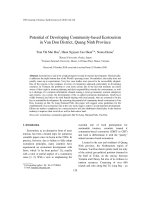
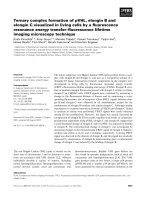
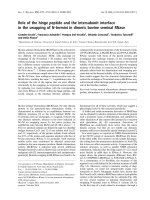
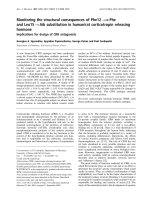
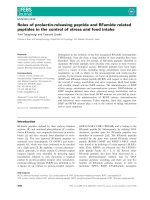
![Báo cáo khoa học: Benzo[a]pyrene impairs b-adrenergic stimulation of adipose tissue lipolysis and causes weight gain in mice A novel molecular mechanism of toxicity for a common food pollutant doc](https://media.store123doc.com/images/document/14/rc/rp/medium_luUKRIz7Xm.jpg)
